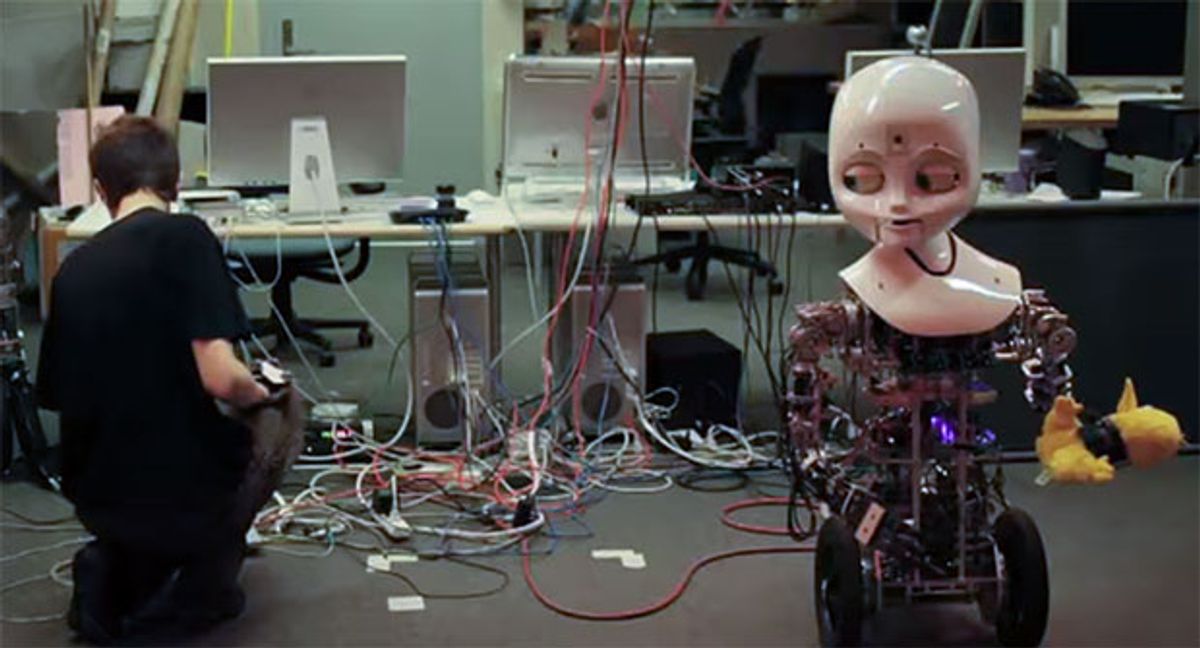It’s been a busy week this week, full of new robots from both Universal Robots and Rethink Robotics. It’s not a coincidence that both of those announcements happened this week: Automate, “North America’s Broadest Automation Event” (whatever that means) kicks off in Chicago on Monday. We wouldn’t be surprised to hear about a few more new industrial or manufacturing robots over the next few days, and at the very least, some cool new demo videos should pop up. If they do, we’ll have them for you, but for this week, you’ll just have to settle for all the other cool videos we’ve dug up. Enjoy!
Earlier this week we showed you an alpha prototype of Tega, a new social robot from MIT. Here’s video of the (half naked) beta version:
[ Tega ]
A month ago, DARPA announced their Robots4Us video contest. Entries are due April 1 (no joke), and you can win a trip to the DRC Finals, as long as you’re a high school student.
[ Robots4Us ]
This is what happens when you threaten a robot arm holding cookies:
[ PickNik ]
Optimized or not, UMD’s RoboRaven flapping-wing fliers are beautiful, and somehow the noise that they make is just so satisfying:
[ UMD ]
I have no idea what this is but it’s hilarious:
That’s not entirely true. I have some idea of what this is, thanks to the video description:
On Saturday, October 11, 2014, nine high school students from The Franklin Institute’s (TFI) Partnerships for Achieving Careers in Technology and Science (PACTS) program participated in Kodlab’s art and robotics workshop, “TOBI in the House”. Students collaborated in groups of 3 to produce a video art piece with TOBI (teaching oriented biologically inspired) Robot, a four-legged robot, by developing a narrative, creating a set design and physically programming the robot's performance. This was one of the videos from the workshop.
[ Kodlab ]
Adooorable and awesome and Iron Man, if you haven’t yet seen this:
With some robotic limbs, you can do all kinds of crazy stuff. Here’s a few examples, with my favorite move at 2:20:
[ hinamitetu ]
It’s fun to watch aerial FPV racing from the perspective of the drones, but unexpectedly, it’s also fun to watch them zip past from ground level:
Looks like the people who brought the world Robothespian are working on a new robot with functional force-controlled legs called Byrun. The flexibility here is making me a little bit jealous:
[ Engineered Arts ]
Remember those tensegrity robots that we wrote about a few weeks back? Here’s one flopping around at UC Berkeley:
[ BEST Lab ]
This September, ESA astronauts will be controlling robotic rovers on Earth all the way from spaaace:
[ ESA Telerobotics ]
You know something’s up when Nexi is looking this shifty. And something is up, as Nexi has figured out how to manipulate the mental state of humans:
What could possibly go wrong? I’ll tell you what could possibly go wrong: everything. All of it. Time to panic.
From John Jordan and ROS News:
I am pleased to announce "Rhoeby", a new ROS-enabled hexapod robot. Rhoeby is a customized version of the Robotis Bioloid kit. It uses low-cost, light-weight 2D Scanning technology available from Rhoeby Dynamics (based on the TeraRanger 1DOF sensor), and supports SLAM, Navigation and Obstacle Avoidance.
In this research, we aim at developing observation technologies of debris flow after volcano eruption using multiple units of multi-rotor MUAVs (Micro Unmanned Aerial Vehicles). On Dec.8-9, 2014, verification tests of volcanic observation were conducted in Sakurajima-Island. In one of the test missions was to observe the active volcano crater. Our MUAV flew to the Showa crater (4km away from the departure point) based on the pre-determined path and returned within 20 minutes. In addition, 3D terrain map was generated by many 2D high-resolution photos based on Structure From Motion (SFM) technique. Smart3Dcapture, commercially available software, was used for the purpose. This video clip includes the above topics and soil-sampling experiment using multi-rotor UAV.
Finally, if this is your very first Video Friday, congratulations! You might get some good info out of this 10-minute-long history of robotics video, somewhat deceptively entitled “A Brief History of Robotics.”
[ SciShow ]
Evan Ackerman is a senior editor at IEEE Spectrum. Since 2007, he has written over 6,000 articles on robotics and technology. He has a degree in Martian geology and is excellent at playing bagpipes.



